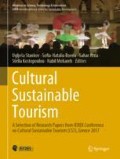Abstract
Ha Long Bay—the United Nations Educational, Scientific and Cultural Organization (UNESCO) World Heritage Site on Vietnam’s northeastern seacoast—is often considered one of the world’s most beautiful bays. This bay is also famous for many floating fishing villages where the people live together on the sea as a community. However, due to rapid population growth in the floating villages, the present situation shows lacks in urban planning, waste management and development of infrastructure. Ha Long Bay had suffered the pressure of environmental pollution and resource degradation. Since 2014, in order to protect the UNESCO World Heritage Site, the local authority has planned a project to demolish the floating villages and move these communities to the mainland. In fact, the demolition project has caused the loss of cultural heritage and a tourist attraction in Ha Long Bay. The goal of this study is to propose a sustainable concept of living space organization for Cua Van, the largest floating village in Ha Long Bay, in order to preserve, revive, and promote floating communities as a unique heritage culture and tourist attraction. Therefore, a detailed analysis of environment and socio-cultural, economic, architectural characteristics of Cua Van is provided in this study. The analysis does not only accumulate precious traditional values that need to be preserved and developed in the proposed concept but also illustrate its weakness that need to be addressed to optimally design the future sustainable floating village. Based on these studies, as well as on general principles of a sustainable floating community and promoting ecotourism, the study proposes a living space concept for Cua Van, including solutions to both a sustainable floating community adapting to climate change and ecotourism development. The proposed concept would ensure stable and permanent living on the water for water dwellers and reduce human-induced impacts on the environment as well as an increasing livelihood income by tourism development.
Access this chapter
Tax calculation will be finalised at checkout
Purchases are for personal use only
References
The report of People’s Committee of Ha Long city in 2010.
Nguyen, D. T. The role of floating fishing villages in the social life of fishers in the South Central Region. In K. Ruddle & P. L. Tuong (Eds.), The van chai of Vietnam: Managing nearshore fisheries and fishing communities. Hong Kong: International Resources Management Institute, 2009, pp. 36–46.
Dr. Nhu Van Can & Dr. Pham Anh Tuan. Marine Fish Farming In Vietnam - Submergible Cage Design Could Support Offshore Culture. Global Aquaculture Alliance 2012.
Pioneering tourism in fishing villages, Ha Long Bay, Vietnam, downloaded on website http://www.docs.vn.
Trang, N. T. T. (2016). Architectural Approaches to a Sustainable Community with Floating Housing Units Adapting to Climate Change and Sea Level Rise in Vietnam. World Academy of Science, Engineering, and Technology, International Journal of Civil, Environmental, Structural, Construction and Architectural Engineering, 10(2), 168–179.
Nguyen, D. T, Kenneth Ruddle. Managing Coastal and Inland Waters. Vietnam: The van chai System of Social Organization and Fisheries Community Management. Springer, 2010, ch.6, pp. 129–160.
The Master Plan for Conservation and Promotion of Ha Long Bay up to 2020, published by People’s Committee of Quang Ninh province 2012.
Abbas Mahravan. (2012) Eco-Tourism and its Architecture: A Methodological Framework for Assessing Progress towards Sustainable Development. A thesis submitted to the Victoria University of Wellington in fulfillment of the requirements for the degree of Doctor of Philosophy in Architecture.
Roy Ballantyne and Karen Hughes. Interpretation in Ecotourism Settings: Investigating tour guides’ perceptions of their role, responsibilities and training needs. The journal of tourism studies Vol. 12, No. 2, Dec. ’01.
Cesar Cuello Nieto, Fundacion Neotropica, Sustainable Communities in a Self-Sufficient Province: “Planning Our Future Together”, April 2008 PHIL & TECH 2:2 Winter 1997 Cuello, Holistic Approach to Ideal of Sustainability 41.
The International Ecotourism Society (TIES), Ecotourism Definition and Principles, 2015 https://ecotourism.org/what-is-ecotourism/
Author information
Authors and Affiliations
Corresponding authors
Editor information
Editors and Affiliations
Rights and permissions
Copyright information
© 2019 Springer Nature Switzerland AG
About this chapter
Cite this chapter
Trang, N.T.T., Vukorep, I., Stopp, H. (2019). Floating Village Cua Van: Promoting Climate-Adaptive Ecotourism with Principles of Living Spaces. In: Stankov, U., Boemi, SN., Attia, S., Kostopoulou, S., Mohareb, N. (eds) Cultural Sustainable Tourism. Advances in Science, Technology & Innovation. Springer, Cham. https://doi.org/10.1007/978-3-030-10804-5_2
Download citation
DOI: https://doi.org/10.1007/978-3-030-10804-5_2
Published:
Publisher Name: Springer, Cham
Print ISBN: 978-3-030-10803-8
Online ISBN: 978-3-030-10804-5
eBook Packages: Earth and Environmental ScienceEarth and Environmental Science (R0)

